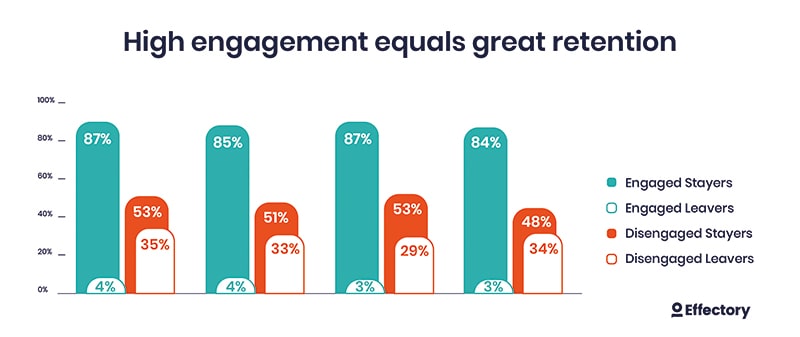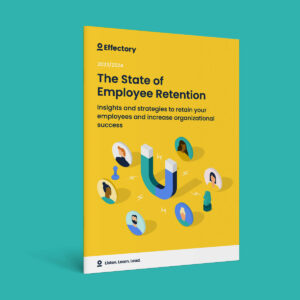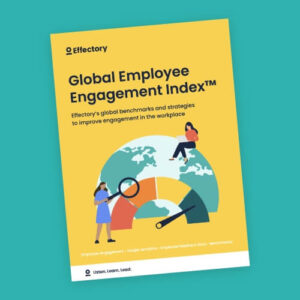In the war for talent, employee retention is more important than ever. Businesses don’t want their best employees looking for opportunities elsewhere. But did you know that up to 55% of disengaged employees are actively seeking job opportunities outside of their organization? In this article, Effectory explains how engagement is one of the most important factors in boosting retention.
Here’s how engagement and retention are related

What is retention and engagement?
As we’ve explained in a previous article, retention is the measure by which organizations can track how long talent stays engaged and with a company. A high retention rate means that people are staying in the same organization or role for a long amount of time, while a low retention rate means that talent is leaving often, which is costly in terms of money, productivity and expertise for any business.
Engagement is the dedication and commitment an employee has to their organization. It describes the relationship between employees and their employer and is linked to the employee experience. High engagement means that an employee feels connected and enthusiastic about their work and feels part of the organization.
It’s no surprise that these two concepts are closely linked.
The State of Employee Retention
Uncover why employees leave, hidden costs to organizations, and proven retention strategies in our insightful report.
DownloadThe connection between engagement and retention
Effectory has been specializing in engagement surveys for over two decades, and along the way we’ve collected data that shows the correlation between engagement and retention.
Many of our customers are often keen to find out about potential future retention rates by asking employees about their intentions to stay in their current position or the organization.
Through our platform, they can ask employees to anonymously inform them whether they’ve recently looked for a job elsewhere, or whether they plan to in the next few months, and – if they are job hunting – whether they are looking inside or outside the organization.
Organizations also survey their workforce about their engagement levels, which in our theme encompasses commitment. You can find out more about how we measure engagement here.
Now we are able to see how engagement and retention are related. The results are startling.
Create impact with People Analytics
Link feedback from employees to your organization’s performance
DownloadHigh engagement equals great retention
Based on our data spanning 2018-2021, which each year has had a sample size of over 25,000 employees in over 400 companies, in 2020 and 2021 only 3% of engaged employees were looking for new job outside of their organization. Compare this to disengaged employees, who in the same years were 9.6x and 11.3x more likely to be looking for a job.

In 2021, disengaged employees were 11.3x more likely to be looking for a new job outside of their organization than their engaged colleagues.
Meanwhile, across this four year period, only around 50% of disengaged employees were sure that they were going to stay in their current roles. Given that, according to Gallup, the amount of employees in the US who are engaged sits at around 36%, we can deduct that a big proportion of the workforce is potentially looking to exit and find opportunities elsewhere.
Of course, not everyone who is not engaged is actively disengaged, but with turnover costing employers around 33% of the replaced employee’s annual salary (Forbes), it’s time to start thinking seriously about increasing engagement to increase retention.
It’s time to cultivate engagement and boost retention
Now that we’ve seen the strong link between employee engagement and retention, let’s take a look at some of the factors that influence engagement.
Engagement is more than commitment. In fact, we measure commitment as part of engagement. Engagement encompasses the dedication employees have to their work and organization.
Here’s some of the factors that influence employee engagement:
Autonomy
A majority of the time, employees want to have clear knowledge of what is expected from them, but they also want the space and responsibility to self-determine how they accomplish their tasks. Micro-management is everyone’s worst nightmare, while a reciprocal sense of trust between management and staff can be the basis of a productive and positive work environment.
Upward mobility
Few want to be stuck in one position forever. Especially younger generations, for whom moving between positions and even careers is something that is expected. Employees are keeping an eye on what sort of promotions and professional development opportunities are being offered by their organizations, and also elsewhere. It’s worthwhile to have leadership development initiatives through which less senior employees, and employees from a diverse array of backgrounds and experiences, can be brought up into management and, eventually, the board.
Continuous learning
Tied with upward mobility is learning and development. Employees can’t be expected to progress or innovate if they’re missing skills that are essential to new processes, workflows, or technology.
Recognition
Regular feedback and a recognition of achievements are small actions but go a long way in making employees feel valued.
Trust in leadership
Trust in leadership is often best maintained when employees feel that their considerations are being taken into account. Transparency regarding business decisions being made is another good way to build trust between employees, management and the C-suite.
A sense of connection
Good communication is crucial to having a strong sense of connection. But this factor also includes things such as sustainability and diversity, equity & inclusion initiatives. Employees are wondering whether their organization is progressing on topics that are important to them and making a positive societal impact.
Global Employee Engagement Index™
Discover the Global Employee Engagement Index™ 2025 for key insights on driving employee engagement, improving performance, and enhancing team dynamics.
DownloadBuilding engagement: what’s next?
We’ve identified some of the factors that influence engagement and have discussed how high engagement levels positively influence retention. It’s time to think about the practical steps that can be taken.
Organizations may already have development funds and initiatives in place, but maybe employees need more guidance and encouragement to take up these opportunities. Perhaps lots of actions are being taken in relation to an organization’s sustainability and environmental impact, but no one knows about it so they think that nothing is being done.
It’s great if leadership can take bold steps and be thought leaders in these areas, but it’s especially beneficial if employees can be engaged throughout the whole process and have an impact upon operational decisions.
The best way to do this is by running a continuous feedback loop so that HR and management get a birds eye view of what their business looks like from the inside. Along the way, they will also find out what it is they’re already doing but isn’t known about, or what they’re missing out on that could be very important for business growth in the mid and long term.
We talk more about how to boost retention and engagement with the power of employee feedback in this article.
Book a free demo. See our solutions in action.
Effectory is Europe’s Leading provider of Employee Listening Solutions. Schedule a product demo and discover how to enhance your employees’ engagement.
Demo request


